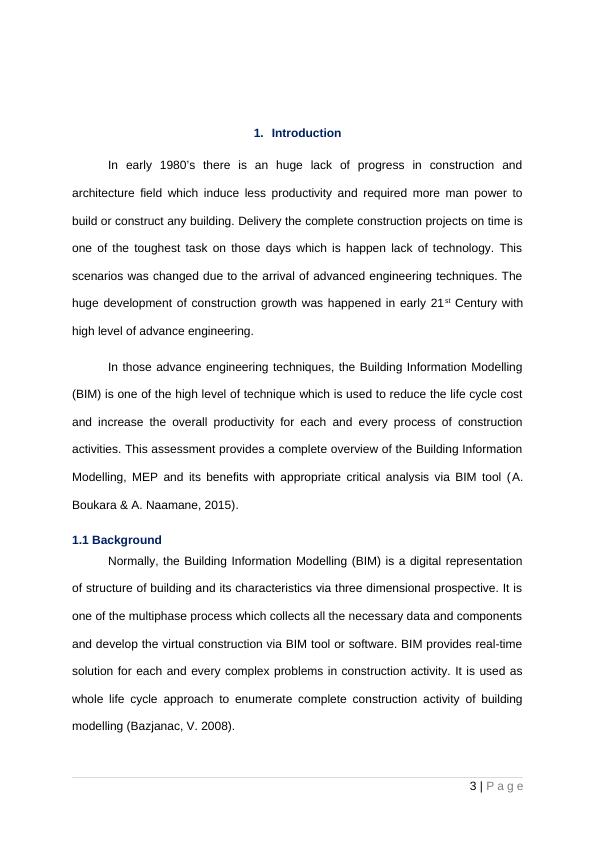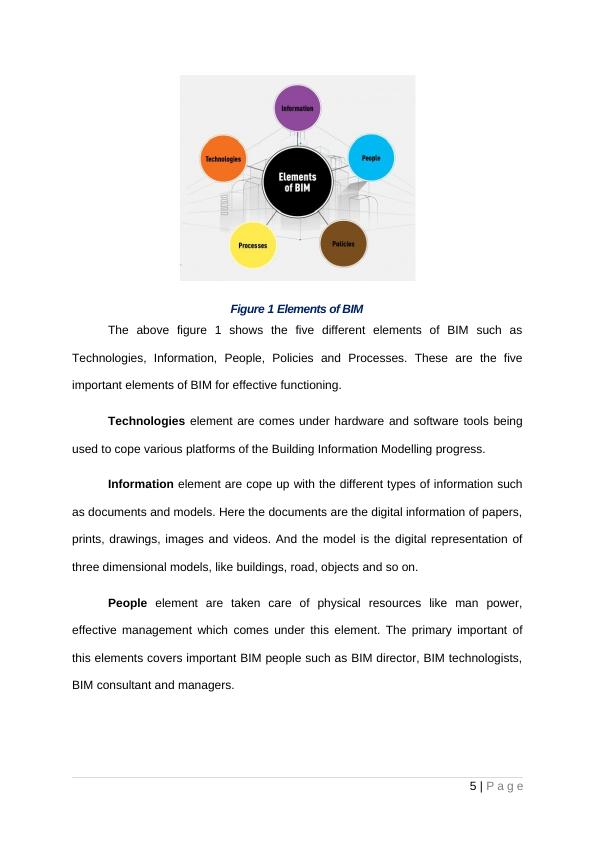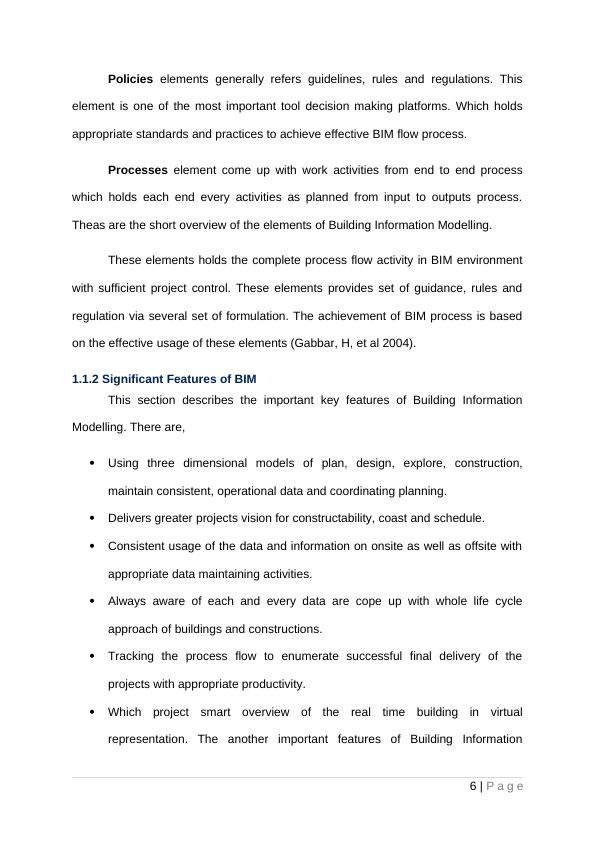Ask a question from expert
Building Information Modelling (BIM) Assignment
40 Pages7435 Words497 Views
Added on 2019-10-09
Building Information Modelling (BIM) Assignment
Added on 2019-10-09
BookmarkShareRelated Documents
BUILDING INFORMATIONMODELLING AND MEPASSESSMENT

Contents1.Introduction............................................................................................................31.1 Background.........................................................................................................31.1.1 Elements of BIM...........................................................................................41.1.2 Significant Features of BIM..........................................................................61.2 Scope of Assessment..........................................................................................62.Literature Survey...................................................................................................82.1 Building Information Modelling............................................................................92.1.1 B for Building................................................................................................92.1.2 I for Information..........................................................................................102.1.3 M for Modelling...........................................................................................102.1.4 Important Benefits of BIM...........................................................................112.2 Levels of Building Information Modelling..........................................................112.2.1 Level 0........................................................................................................122.2.2 Level 1........................................................................................................132.2.3 Level 2........................................................................................................132.2.4 Level 3........................................................................................................132.3 Building Information Modelling Risks................................................................142.3.1 Communication..........................................................................................142.3.2 Control........................................................................................................152.3.3 Design Errors.............................................................................................152.3.4 Construction Costs.....................................................................................152.3.5 Avoiding Errors...........................................................................................162.4 How BIM Mitigate building and construction Risks?.........................................162.4.1 Safety.........................................................................................................162.4.2 Negative Project Events.............................................................................172.4.3 Depth Analysis...........................................................................................172.5 BIM – Multi Dimensional Function....................................................................172.5.1 Client..........................................................................................................182.5.2 Construction Site........................................................................................192.5.3 Facility Manager.........................................................................................192.5.4 Architect......................................................................................................202.5.5 Consultant..................................................................................................202.5.6 Contractors and Sub-contractor.................................................................201 | P a g e

2.6 BIM-Based MEP................................................................................................203.Critical Analysis and Discussion of BIM Model...................................................243.1 Basic Data of our building.................................................................................243.1.1 Annual Energy Use....................................................................................243.2 Building Information Modelling..........................................................................243.3 Results and Discussion.....................................................................................273.3.1 Annual Data................................................................................................273.3.2 Monthly Data..............................................................................................283.4 Results after Modifications............................................................................303.5 Energy Consumption.........................................................................................314.Conclusion...........................................................................................................33References.................................................................................................................34List of FiguresFigure 1 Elements of BIM.............................................................................................5Figure 2 Important Benefits of BIM.............................................................................11Figure 3 Levels of Building Information Modelling.....................................................12Figure 4 BIM Dimensions...........................................................................................18Figure 5 Factors involved in MEP Coordination Approaches....................................21Figure 6 Average use of Frequency of MEP approach..............................................22Figure 7 Suggestions to Progress Design Coordination Effectiveness.....................23Figure 8 Pictorial representation of Model..................................................................25Figure 9 Project summary..........................................................................................25Figure 10 Building Summary......................................................................................26Figure 11 Zone Summary...........................................................................................26Figure 12 Annual Data of total energy........................................................................27Figure 13 Annual Data of electricity...........................................................................27Figure 14 Annual Data of Fuel....................................................................................28Figure 15 Monthly Data of total energy......................................................................28Figure 16 Monthly Data of electricity..........................................................................29Figure 17 Monthly Data of fuel...................................................................................29Figure 18 Energy Analysis Results............................................................................31Figure 19 Energy Consumption..................................................................................32Figure 20 Energy savings due to alternate design.....................................................322 | P a g e

1.IntroductionIn early 1980’s there is an huge lack of progress in construction andarchitecture field which induce less productivity and required more man power tobuild or construct any building. Delivery the complete construction projects on time isone of the toughest task on those days which is happen lack of technology. Thisscenarios was changed due to the arrival of advanced engineering techniques. Thehuge development of construction growth was happened in early 21st Century withhigh level of advance engineering.In those advance engineering techniques, the Building Information Modelling(BIM) is one of the high level of technique which is used to reduce the life cycle costand increase the overall productivity for each and every process of constructionactivities. This assessment provides a complete overview of the Building InformationModelling, MEP and its benefits with appropriate critical analysis via BIM tool (A.Boukara & A. Naamane, 2015).1.1 BackgroundNormally, the Building Information Modelling (BIM) is a digital representationof structure of building and its characteristics via three dimensional prospective. It isone of the multiphase process which collects all the necessary data and componentsand develop the virtual construction via BIM tool or software. BIM provides real-timesolution for each and every complex problems in construction activity. It is used aswhole life cycle approach to enumerate complete construction activity of buildingmodelling (Bazjanac, V. 2008). 3 | P a g e

The BIM have lots of advantages and the primary one is to reduce theresources, time and life cycle cost from the building construction and design, whichencompasses the three dimensional building structure, geographical information,spatial relationships, properties and quantities of the construction components whichincludes the whole life cycle process of building and facility operations.Generally, BIM is one of the object oriented program which facilitated withComputer Aided Design (CAD) which support the three dimensional representationof whole building modelling. Which provides several important activities in buildingconstruction field such as design, plan, construction, infrastructure and managebuildings (Ford, S, et al.1995). The BIM activities includes contributors fromcomplete projects life cycle such as engineer, architect, owner, contractor, facilitiesmanagements and so on. BIM is not just a software which provide more accuratemodelling date includes high level of creativities with appropriate process design.The BIM not only generate the model which provides several analysis like multimodelling and provide more accurate energy modelling data via virtual approach(Ford, S, et al.1995).1.1.1 Elements of BIMThe Building Information Modelling comprises of five different elements whichprovide complete life cycle progress of building construction effectively (Hoekstra, J.2003). 4 | P a g e

Figure 1 Elements of BIMThe above figure 1 shows the five different elements of BIM such asTechnologies, Information, People, Policies and Processes. These are the fiveimportant elements of BIM for effective functioning.Technologies element are comes under hardware and software tools beingused to cope various platforms of the Building Information Modelling progress.Information element are cope up with the different types of information suchas documents and models. Here the documents are the digital information of papers,prints, drawings, images and videos. And the model is the digital representation ofthree dimensional models, like buildings, road, objects and so on.People element are taken care of physical resources like man power,effective management which comes under this element. The primary important ofthis elements covers important BIM people such as BIM director, BIM technologists,BIM consultant and managers.5 | P a g e

Policies elements generally refers guidelines, rules and regulations. Thiselement is one of the most important tool decision making platforms. Which holdsappropriate standards and practices to achieve effective BIM flow process.Processes element come up with work activities from end to end processwhich holds each end every activities as planned from input to outputs process.Theas are the short overview of the elements of Building Information Modelling. These elements holds the complete process flow activity in BIM environmentwith sufficient project control. These elements provides set of guidance, rules andregulation via several set of formulation. The achievement of BIM process is basedon the effective usage of these elements (Gabbar, H, et al 2004).1.1.2 Significant Features of BIMThis section describes the important key features of Building InformationModelling. There are,Using three dimensional models of plan, design, explore, construction,maintain consistent, operational data and coordinating planning.Delivers greater projects vision for constructability, coast and schedule.Consistent usage of the data and information on onsite as well as offsite withappropriate data maintaining activities.Always aware of each and every data are cope up with whole life cycleapproach of buildings and constructions.Tracking the process flow to enumerate successful final delivery of theprojects with appropriate productivity.Which project smart overview of the real time building in virtualrepresentation. The another important features of Building Information6 | P a g e

Modelling is to provide error free environment in various aspects of project lifecycle managementThese are the important significant of building Information Modelling on eachstages of the flow process (Donath, D et al. 2004). 1.2 Scope of AssessmentThe primary scope of this assessment is to involve in the critical analysis of anexisting structure from the prospect of Building Information Modelling withstructured use of MEP software solutions. These critical analysis are carried withthe help of power BIM tool Autodesk Revit with appropriate background research.This assessment will deliver following activities in detail manner with appropriateanalysis.Industrial uses of Building Information Modelling with MEP packages, howBIM is important in construction fields and its impacts.Application of BIM approaches in design projects problems and how BIMprovide real life solution of existing problems via software tool with properprocess flow activities.Understanding the importance of BIM and MEP with project developmentactivities from end to end support. How BIM holds and helps differentstages of design projects in multidisciplinary environment.Wide ranges of research study of Electrical, Mechanical, Plumbing and firerelated application in BIM environmentMeeting Industrial standards and approaches with proper process flowactivity of complete projects. How the information are being used to ensurethe effective BIM environment.7 | P a g e

End of preview
Want to access all the pages? Upload your documents or become a member.
Related Documents
Building Information Modelling and MEP Assessmentlg...
|8
|1228
|304
Building Information Modeling and Collaborative Contracting in Construction Industrylg...
|37
|8979
|266
The Contribution of DYNAMO Visual Programming Software in the Evolution of BIMlg...
|50
|19073
|28
Connecting Rod Design and FEA Analysis - Deskliblg...
|56
|4240
|96
Development of a New Information Technology Centre – Stage 3lg...
|9
|1217
|69
Database in Software Engineerlg...
|27
|3556
|21